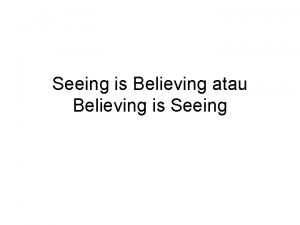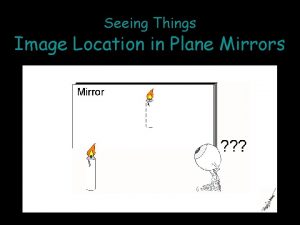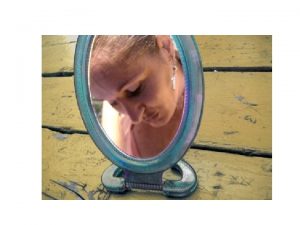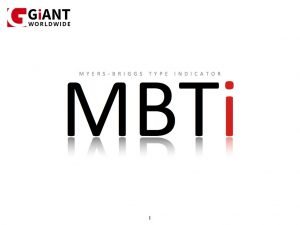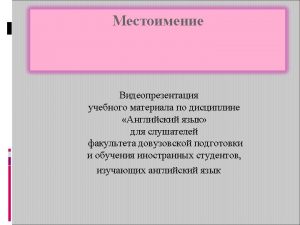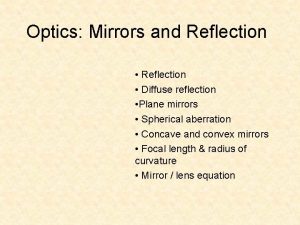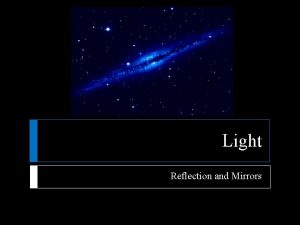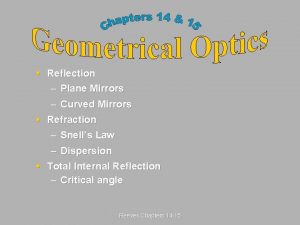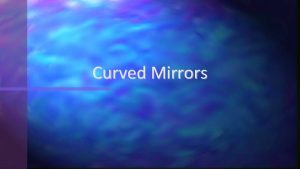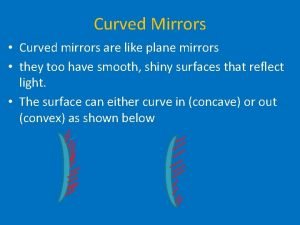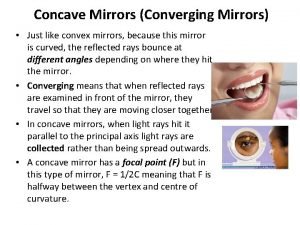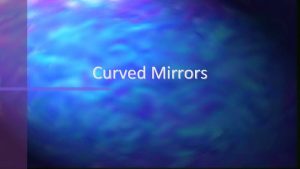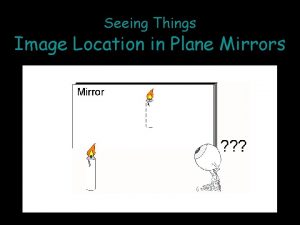Reflection and Mirrors Seeing Yourself Law of Reflection












- Slides: 12

Reflection and Mirrors Seeing Yourself

Law of Reflection The law of reflection states that the angle of incidence is equal to the angle of reflection.

Definitions Incident ray is the ray moving toward the surface Reflected ray is the ray moving from the surface Normal is an imaginary line perpendicular to the surface

More Definitions Angle of incidence is the angle between the incident ray and the normal Angle of reflection is the angle between the reflected ray and the normal

Plane Mirrors Image is the same size as the object Image is the same distance behind the mirror as the object is in front of the mirror. The front and back of the image of are reversed. Virtual image.

Images An Image is the point where extended rays of light intersect. Real image—formed by converging light rays and can be displayed on a screen Virtual Image—an image that can be seen by the observer but cannot be projected on a screen because light from the object does not actually come to a focus.

Regular Reflection Rays of light hit a smooth surface. The reflected rays bounce off the surface parallel to each other.

Diffuse Reflection Rays of light hit a rough surface. The reflected rays are not parallel to each other when they bounce off the surface.

Concave Mirrors Concave mirrors are shaped like the inside of a spoon Parallel rays of light are reflected towards a single point—the focal point The real image is inverted and in front of the mirror. The virtual image is erect and behind the mirror.

Convex Mirrors A convex mirror is shaped like the outside bottom of a spoon. Convex mirrors produce an erect virtual image behind the mirror. Convex mirrors are used as rearview mirrors in cars and in stores to observe shoppers.

Spherical Aberration Curved mirrors that are made from part of a sphere do not reflect all rays of light through the focal point. Parabolic mirrors are used when a sharp focus is needed—they do not have spherical aberration.

The Mirror Equation f is the focal length (distance from mirror to focal point) do is the distance from the mirror to the object di is the distance from the mirror to the image The focal length of a curved mirror is ½ of the radius of curvature.
 Seeing is believing atau believing is seeing
Seeing is believing atau believing is seeing Plane mirror location
Plane mirror location Chapter 17 reflection and mirrors
Chapter 17 reflection and mirrors Physics
Physics Salamander fahrenheit 451
Salamander fahrenheit 451 Know yourself to lead yourself
Know yourself to lead yourself Check yourself before you wreck yourself origin
Check yourself before you wreck yourself origin Myself themselves yourselves
Myself themselves yourselves Ict in education images
Ict in education images Newton's first law and second law and third law
Newton's first law and second law and third law Si unit of newton's first law
Si unit of newton's first law Boyle's law charles law avogadro's law
Boyle's law charles law avogadro's law P=k/v
P=k/v
